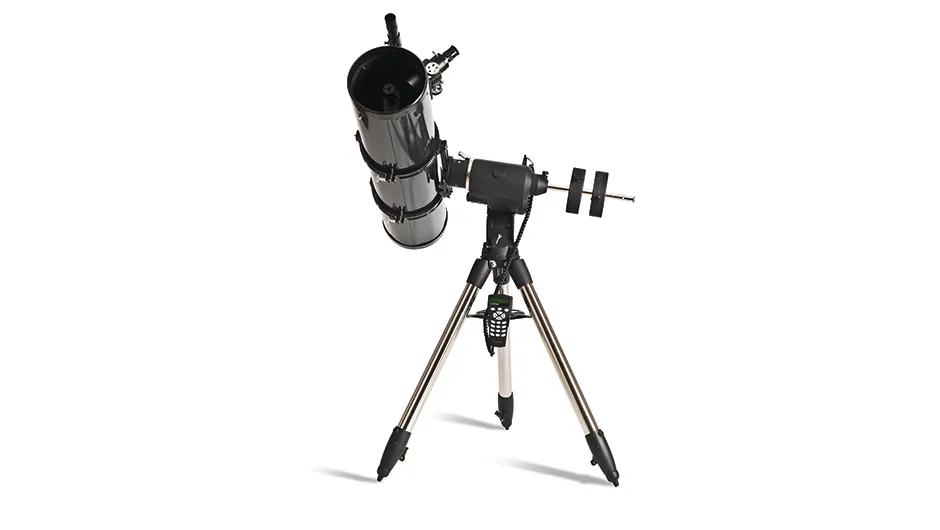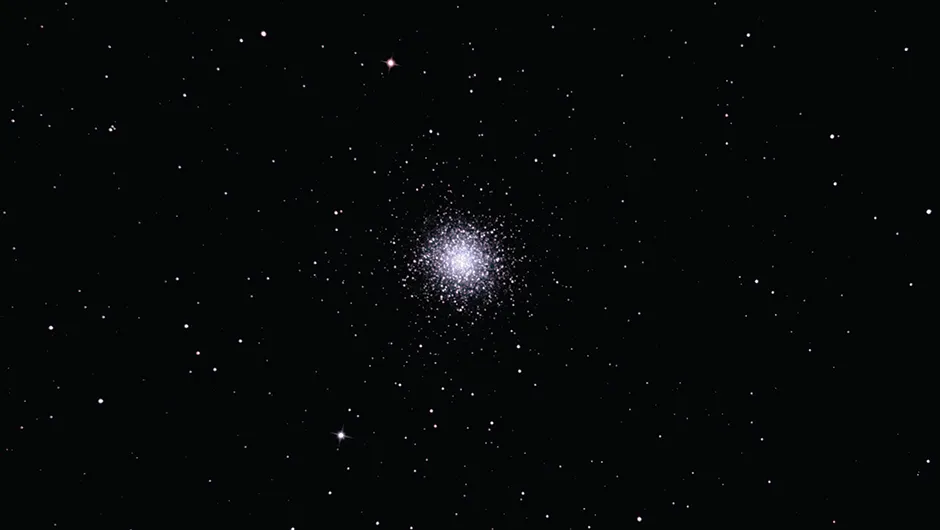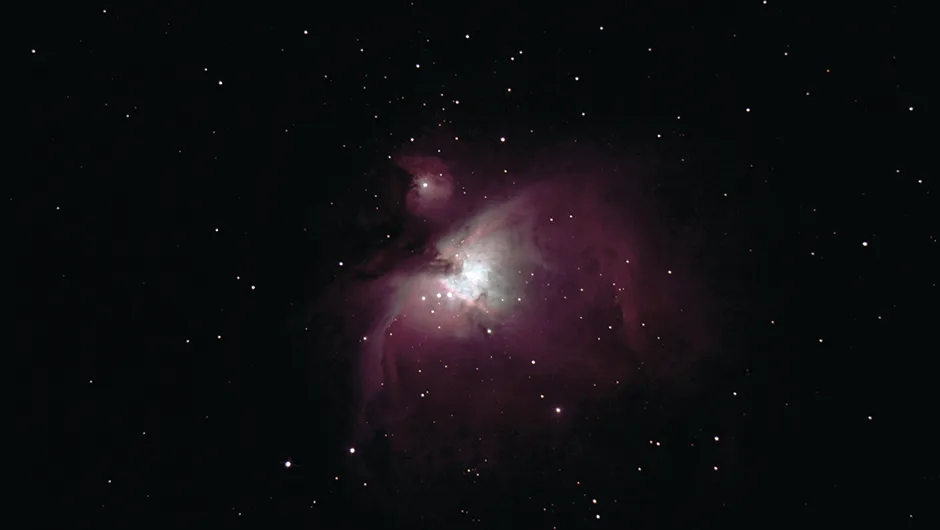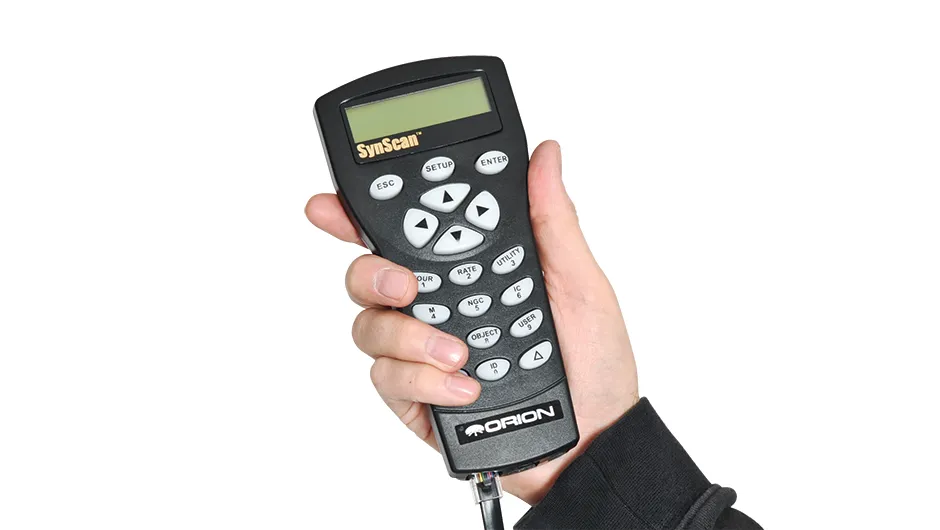Price: £1599.00
Aperture: 203mm; 8 inches
Focal Length: 1000mm; f/4.9
Eyepieces: 25mm 1.25-inch fit
Mount: Atlas EQ-G Go-To
Weight: 43kg
Supplier: Widescreen Centre
Telephone: 0207 935 2580
Website: www.widescreen-centre.co.uk
From the first humble model created bySir Isaac Newton, the reflecting telescope continues to develop as technology brings new versatility to a trusted design.
Modern computerised reflectors would astound Newton with what they can offer observers, especially Orion Telescopes & Binoculars’ new 8-inch Atlas Go-To equatorial Newtonian.
The Atlas EQ-G mount is very sturdy and has ports for the hand controller and for connecting an autoguider.
It is good to see that the hand controller cable can be attached firmly to the mount so it can’t come loose accidentally, although we would like to see the same principle applied to the power cable connector, which is just as important.

The mount also comes with three 5kg counterweights to balance the system for both visual and imaging purposes, while the steel tripod is pretty rigid and comes with an eyepiece holder.
Using the comprehensive manual provided, it’s easy to put together the tube assembly, comprising 8-inch (203mm) diameter, f/4.9 telescope tube,tube rings with Vixen-style dovetail plate, 8x40 finderscope and 2-inch Crayford focuser with 1.25-inch adaptor.
It also comes with a 25mm, 1.25-inch fit Sirius Plössl eyepiece, a prime-focus photography adaptor for attaching a camera anda collimating cap.

Take control
The SynScan hand controller was quite user-friendly for initial alignment and setup.
The procedure involves one-, two- or three-star alignment; using three stars meant that objects stayed in the central field of view for longer observing periods.
We did several slew tests moving the scope from the star Arcturus, low in the east, to the star Capella, low in the west.
The scope took an average of just 45 seconds to go from one to the other, so you can move around the sky reasonably quickly.
Next, we viewed the star Regulus and gauged the quality of the field of view using the supplied 25mm eyepiece. It was very good across 75 per cent with only slight trailing off towards the edges.

With this eyepiece we could frame the entire Pleiades star cluster.
The Atlas 8 only comes with that (25mm) eyepiece, but we pushed the magnification on a few close double stars with our own higher power eyepieces – a 2-inch fit 9mm eyepiece and a 1.25-inch fit 25mm with a 5x Powermate Barlow lens.
The 9mm split the double stars Castor in Gemini and Algieba in Leo with ease, so we turned to a closer double, Xi Ursae Majoris.
This star has two almost equally bright components separated by 1.7 arcseconds. It was easy to split with the 25mm and 5x Powermate – it looked like two distant car headlights.
Satisfied, we then toured a number of deep-sky objects, getting great views of the Orion Nebula including the four Trapezium stars and two of the fainter companion stars, ‘E’ and ‘F’.

The globular cluster M13 was awash with stars, while our tour of the galaxies M81, M82 and M51 were very enjoyable, with subtle detail present along the disc of M82 in particular.
Using the 25mm eyepiece, Saturn was detailed but small, with several moons present. With our higher magnification eyepieceswe saw the Cassini Division in the planet’s rings.
We then attached our Canon 50D DSLR foran imaging test.
The supplied camera adaptor screws into the focuser in place of the eyepiece holder, while at the other end it screws onto your camera-specific adaptor, a Canon one in our case.
This works fine, but it does mean that you can’t rotate the camera to frame the view nicely.

Thefast optics of f/4.9 gave bright images with exposures of 30s at ISO 2000, and although the weather wasn’t particularly co-operative, we didget several nice images of the Orion Nebula and M13 (pictured below), and the galaxy M51.
Overall, the Atlas 8-inch Go-To telescope is a good system with fantastic optics.
It’s also a versatile telescope that’s suitable for both visual use and astro imaging and would make a fine addition to anyone’s stable of instruments.
Optical quality
Although the Go-To system is certainly oneof the main features, we were particularly impressed with the optics of the Orion 8-inch Atlas.
No matter how accurate the Go-To or tracking, it’s the end view that’s the most important thing and we particularly enjoyed those offered by this telescope’s optics.
Being able to push the magnification showed how good the central area of the mirror was. Indeed, on the close double star Porrima we really pushed the magnification, using a 10mm eyepiece with a 5x Powermate Barlow to give a magnification of 500x.
On this very close double star with a separation of just one arcsecond, the view we had showed two closely overlapping Airy discs.
In moments of particularly good seeing, these seemed to split into two stars.
We could also see relatively faint detail in many deep-sky objects, and enjoyed the ability to tease out subtle features in galaxies and nebulae alike, making for a satisfying night’s viewing.
Finderscope
The 8x40 finderscope gave a clear and reasonably bright view, enabling us to locate bright stars for the alignment process and some of the brighter deep-sky objects as well.
Once aligned with the main optical axis, the finder remained aligned throughout the testing process.
Focuser
Getting a perfect focus is essential for seeing detail on planets and in deep-sky objects.
The 2-inch Crayford focuser was smooth to use and could be easily locked in position for astrophotography with the screw on the underside.
It could also take the screw-in camera adaptor for prime focus photography.
Mount
The Atlas EQ-G equatorial mount is a very sturdy mount for this size of telescope, providing a firm, stable platform with hardly any vibration.
The motors are a little noisy at the start of a slew, but very quickly quieten down and are very quiet when in tracking mode.
Hand controller
The Orion Go-To system uses the SynScan hand controller, which was easy to set up and use.
The red glow of the buttons and display weren’t distracting or damaging to night vision and the menus were easy to navigate.
The 42,900-object database provides a good range of objects for you to explore.
Optics
An 8-inch mirror collects 78 per cent more light than a 6-inch mirror, but if the optical surfaces are poorly figured or out of alignment then that extra light could be wasted.
We found there were no apparent defects in the primary or secondary mirror.
There was a little coma, but this was expected due to the fast focal ratio of the optics.
